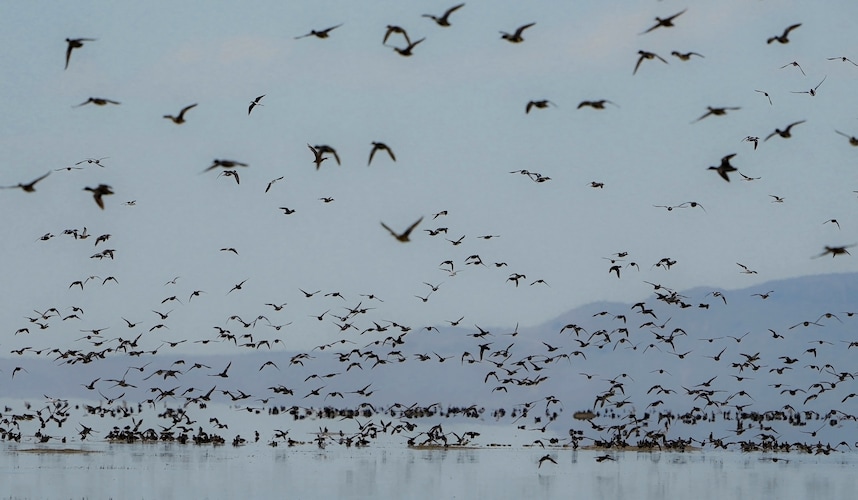Utah author Terry Tempest Williams was sick with pneumonia last winter.
She was in the middle of writing her ode to the Great Salt Lake, which ran in The New York Times in March. She and artist Fazal Sheikh had circumnavigated the lake in November 2022 to document the body of water at the time of its record low.
“I was so completely obsessed with this, even as I was teaching and working,” Williams said to an auditorium filled to capacity at the Salt Lake City Public Library on Saturday.
“And I remember I couldn’t breathe, and I could hear this wheezing,” she continued. “And in my mind, I thought that’s what Great Salt Lake sounds like.”

(Francisco Kjolseth | The Salt Lake Tribune) Thousands of shore birds and waterfowl take flight near the outflow of the Weber River where it meets the Great Salt Lake. The critical bird habitat had received a few inches of water on this Wednesday, April 12, 2023, following a record year for snowpack.
Around 300 people listened to Williams discuss her essay on the lake — “I Am Haunted by What I Have Seen at Great Salt Lake” — during Salt Lake County Mayor Jenny Wilson’s book club event Saturday afternoon. The event featured commentary from Wilson and Ben Abbott, a Brigham Young University professor of aquatic ecology. Abbot authored an emergency briefing on the lake’s status in January.
Williams, who grew up in Salt Lake City, rose to fame as a naturalist and environmental writer with the publication of her 1991 memoir, “Refuge: An Unnatural History of Family and Place.” In the book, she wove together her lifelong reverence for the Great Salt Lake, grief around her mother’s early death to cancer and her familial history with the disease. Williams has since authored several collections of essays, poetry and prose. In 2017, Williams joined the Harvard Divinity School as writer-in-residence. She now splits her time between her home of 25 years in Castle Valley (Grand County), Utah, and Cambridge, Mass.
“This is where I place my faith: in our collective capacity to mobilize now,” Williams said. “If we can shift our view of Great Salt Lake from a lake to be avoided to a lake we cherish; from a body of wasted water to the ancient body of wisdom; not to exploit … but to honor and respect as a sovereign body. Our relationship and actions for the best will be transformative.”
Williams said writing the piece on the lake was the hardest thing she’d ever done, because she knew “it had to matter.” She knew she had to urge people to take action to save the place she knew and loved, but also to “protect the health of those of us living in the heart of Mormon Country,” she wrote in her piece.
When Williams sailed out across the lake with Sheikh, the lake had hit a record low. Its elevation dropped to 4,188.5 feet, according to measurements taken at the South Arm Causeway by the Utah Division of Water Resources.
(Kristin Murphy | Deseret News) Record low water levels are seen in the Great Salt Lake from Antelope Island on Friday, July 22, 2022.
Measurements from July show the south arm of the lake rose about 5 feet after inflow from the winter’s historic snowpack, but the north arm of the lake rose only about a foot. This makes the lake’s overall rise equal to about 3.6 feet — which will shrink to about a 1.2 foot increase by the fall due to summer evaporation, Great Salt Lake Institute director Bonnie Baxter said last month.
Abbott said this year’s snowpack allowed for a reprieve — rewinding the clock by one or two years, in the context of his January estimate that the lake could disappear in the next five years. But the state has had a long history of living outside its means in terms of water usage, Abbott said, so one record year of snowpack won’t solve the problem.
“We must change or die,” Williams wrote after the event, in an email. “One big winter does not solve the plight of Great Salt Lake. It gives us more time to do what we need to do: Mobilize our collective intention to bring water to the lake in the name of active stewardship. We can do this. And we can do this together. We are Great Salt Lake. Salt water runs in our veins.”







